ON THE TABLE - JULY 10, 2013
 Monday, July 8, 2013 at 05:51PM
Monday, July 8, 2013 at 05:51PM
Editor-in-Chief's Note: Late word from deep inside Fiat-Chrysler is that Sergio Marchionne's Grand Plan No. 47 - the resurrection of Maserati to the top tier of the luxury-performance ionosphere - is coming unglued. Sergio has just killed the Jeep Grand Cherokee-based Maserati SUV - complete with its felt-lined owner-engraved mahogany boxed Blue Ray CD owner's manual - that was supposed to be the profit generator for the brand. Sergio was delusional about Maserati's place and potential in the world anyway, but that didn't stop him from spewing his usual gamut of ludicrous promises about how it was going to be once he decided to play in The Game. Typical. More on this next week. - PMD
 Datsun. Editor-in-Chief's Note: Nissan is bringing back its Datsun name for use in emerging markets. This just in: They never should have changed it here. Once upon a time Datsun had tremendous mojo in this market. Datsun, We Are Driven! was a hugely successful ad theme that resonated across America. So did the cars and trucks. Then Nissan the company decided that they had to sync up their American operation over here with its corporate presence in Japan. Why? What did it gain? Not much. I should know, I worked on the account immediately after the name change and it was nothing more than a fool's errand, with Nissan pouring millions into the name change that could have and should have been spent on the perfectly good brand they had. Nissan has some impressive products today - let me reemphasize, some - but the name change remains one of the dumbest moves ever undertaken by a car company in this market. - PMD
Datsun. Editor-in-Chief's Note: Nissan is bringing back its Datsun name for use in emerging markets. This just in: They never should have changed it here. Once upon a time Datsun had tremendous mojo in this market. Datsun, We Are Driven! was a hugely successful ad theme that resonated across America. So did the cars and trucks. Then Nissan the company decided that they had to sync up their American operation over here with its corporate presence in Japan. Why? What did it gain? Not much. I should know, I worked on the account immediately after the name change and it was nothing more than a fool's errand, with Nissan pouring millions into the name change that could have and should have been spent on the perfectly good brand they had. Nissan has some impressive products today - let me reemphasize, some - but the name change remains one of the dumbest moves ever undertaken by a car company in this market. - PMD
(Images courtesy of Jaguar)
The Jaguar Project 7 was created by the team led by Jaguar Director of Design Ian Callum as a one-off design study based on the new 2014 Jaguar F-TYPE. "Project 7 is a single-seat sports car based on the F-TYPE, with the kind of racing-inspired form that designers dream about," said Callum. "It has one purpose: to be driven fast and enjoyed. Jaguar sports cars are known for exceptional performance and clean design. Project 7 captures that spirit in its purest form."
Project 7's name acknowledges Jaguar's winning of Le Mans seven times between 1951-1990, and its blue paintwork is reminiscent of the victorious Jaguar D-type cars of 1956/1957. Powered by a 5-liter supercharged Jaguar V8 engine with 550hp, Project 7 will reach 60mph in 4.1 seconds and attain a top speed of 186mph.
The driver sits in a composite bucket seat in the Jaguar Project 7, which is 1.2 inches lower than the stock seat, and is gripped by a four-point racing harness. The passenger seat is replaced by a custom fabricated helmet holder, which carries a custom-designed Project 7 helmet in matching blue paint and graphics, secured by its own harness. The seat and the insides of the doors are finished in a quilted racing-style diamond pattern. There are carbon-fiber inserts on the console and shift lever, and the steering wheel is equipped with machined aluminum paddles.
The most prominent change is the new D-Type-inspired rear fairing section that incorporates a rollover hoop and swoops down from behind the driver. The convertible top system has been deleted. The Jaguar Project 7 will make its debut at the 2013 Goodwood Festival of Speed, with Chief Engineer Mike Cross at the wheel.
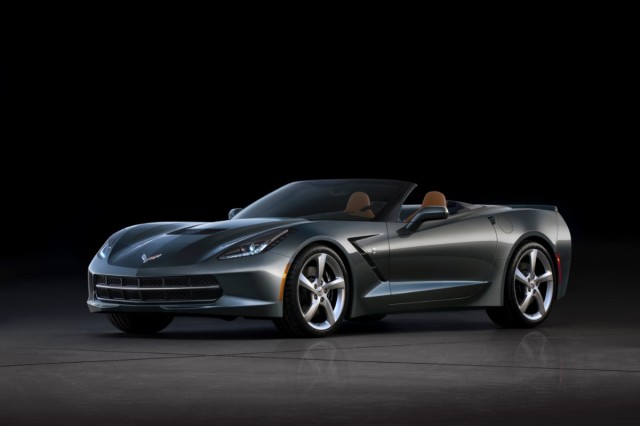 (GM)
(GM)
The 2014 Corvette Stingray (equipped with the 7-speed manual gearbox) will deliver up to an EPA-estimated 17 miles per gallon in the city, and 29 mpg on the highway, making the new Stingray "the most fuel efficient sports car on the market as no other car offers more than 455 horsepower and greater than 29 mpg highway," according to Chevrolet. The estimate reflects an average of fuel economy in both the default “Tour” mode, which delivers 28 mpg highway, and driver-selectable “Eco” mode, which delivers 30 mpg highway. For Corvettes equipped with the seven-speed manual transmission, Eco mode enables Active Fuel Management, which disables four of the cylinders for improved fuel economy during light engine loads.
Editor-in-Chief's Note: Watch this mini-film by Honda entitled "Hands" - Simple. Compelling. Brilliant. - PMD
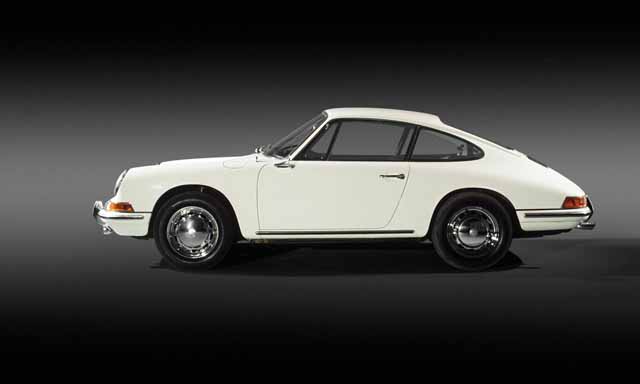 (Images courtesy of Porsche)
(Images courtesy of Porsche)
Porsche is continuing its celebration of the 50th Anniversary of the Porsche 911 at the Goodwood Festival of Speed on July 11-14. A bespoke 911-inspired sculpture will be displayed prominently, as has become the tradition, outside Goodwood House. Porsche is sending many special 911s to the event.
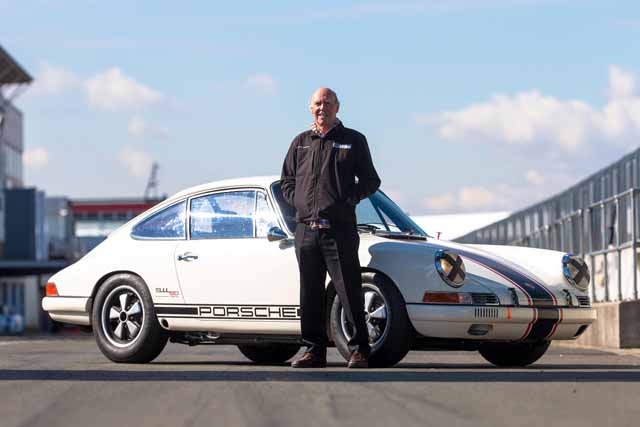 1970 Le Mans winner Richard Attwood and the 1965 Porsche 911 Project 50 created by the factory.
1970 Le Mans winner Richard Attwood and the 1965 Porsche 911 Project 50 created by the factory.
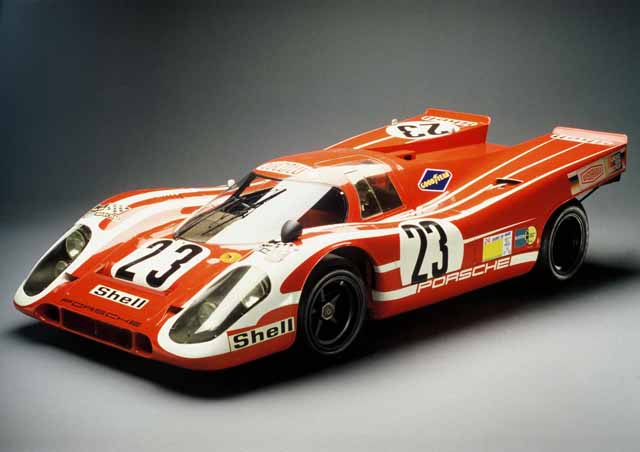 The 1970 Porsche 917 KH 24 Hours of Le Mans winner will be reunited with its former Porsche factory race drivers Hans Herrmann and Richard Attwood at Goodwood. In 1970, seventeen examples of the 917 participated at Le Mans, and after 24 hours of racing in the rain and fog, Porsche secured its first victory in the French endurance event. Porsche has achieved a record total of 16 overall Le Mans victories to date.
The 1970 Porsche 917 KH 24 Hours of Le Mans winner will be reunited with its former Porsche factory race drivers Hans Herrmann and Richard Attwood at Goodwood. In 1970, seventeen examples of the 917 participated at Le Mans, and after 24 hours of racing in the rain and fog, Porsche secured its first victory in the French endurance event. Porsche has achieved a record total of 16 overall Le Mans victories to date.
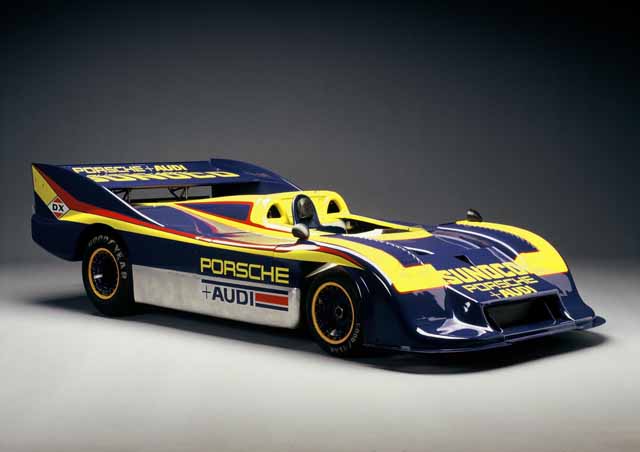 The formidable Porsche 917/30 Can-Am car will also be appearing at Goodwood. The phenomenal 1,000HP+ racing machine prepared and entered by Roger Penske and raced by Mark Donohue remains one of the most iconic racing cars of all time. This is the car that humiliated the once-dominant Team McLaren in the legendary Can-Am series, effectively crippling the series and sending it into permanent decline. In qualifying trim, the turbo-boost could be dialed-up in the all-conquering 917/30 to produce more than 1200HP.
The formidable Porsche 917/30 Can-Am car will also be appearing at Goodwood. The phenomenal 1,000HP+ racing machine prepared and entered by Roger Penske and raced by Mark Donohue remains one of the most iconic racing cars of all time. This is the car that humiliated the once-dominant Team McLaren in the legendary Can-Am series, effectively crippling the series and sending it into permanent decline. In qualifying trim, the turbo-boost could be dialed-up in the all-conquering 917/30 to produce more than 1200HP.
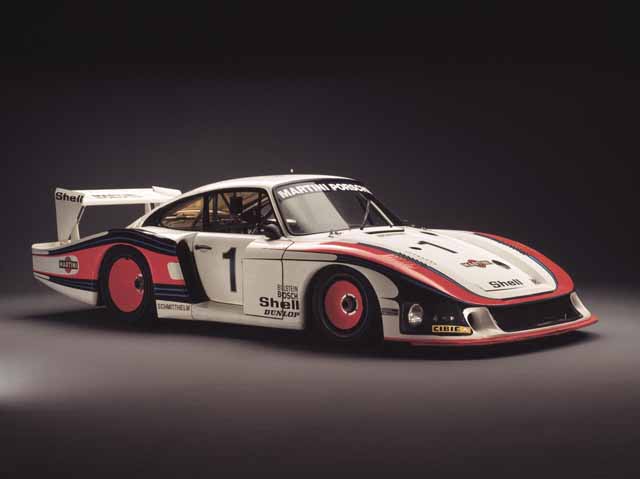 The 1978 Porsche 935 "Moby Dick" was loosely-based on the 911.
The 1978 Porsche 935 "Moby Dick" was loosely-based on the 911.
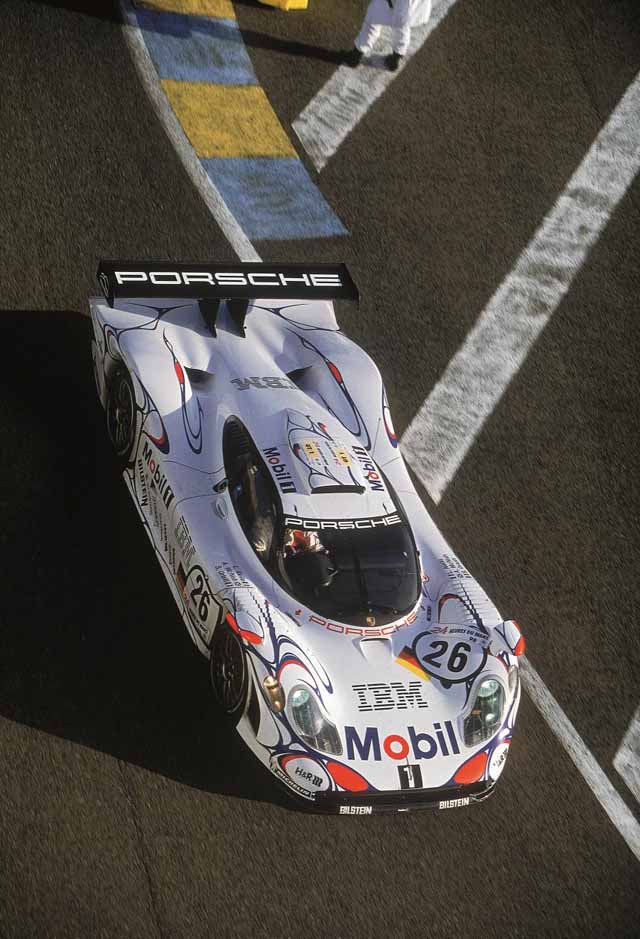 The Porsche 911 GT1 that won the 24 Hours of Le Mans in 1998.
The Porsche 911 GT1 that won the 24 Hours of Le Mans in 1998.
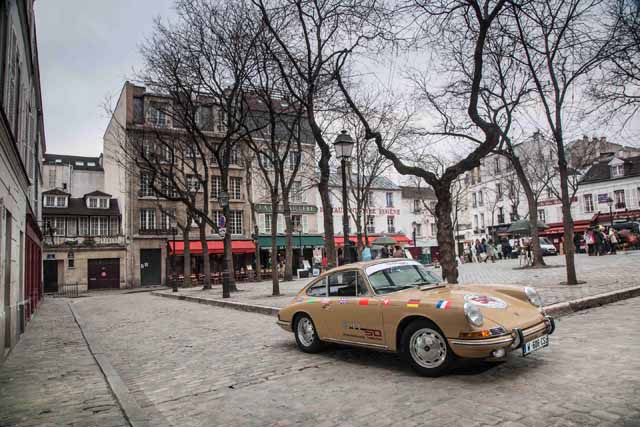 The Porsche Museum is sending a very special, original 911 to Goodwood. As part of the "Follow the 911" world tour, this 1967 Porsche 911 has been engaged as a rolling ambassador for Porsche at various international events, trade fairs, historic rallies and racing events in France (above), China, Pebble Beach, California and Australia during the year. The car’s progress can be followed at porsche.com/follow-911.
The Porsche Museum is sending a very special, original 911 to Goodwood. As part of the "Follow the 911" world tour, this 1967 Porsche 911 has been engaged as a rolling ambassador for Porsche at various international events, trade fairs, historic rallies and racing events in France (above), China, Pebble Beach, California and Australia during the year. The car’s progress can be followed at porsche.com/follow-911.
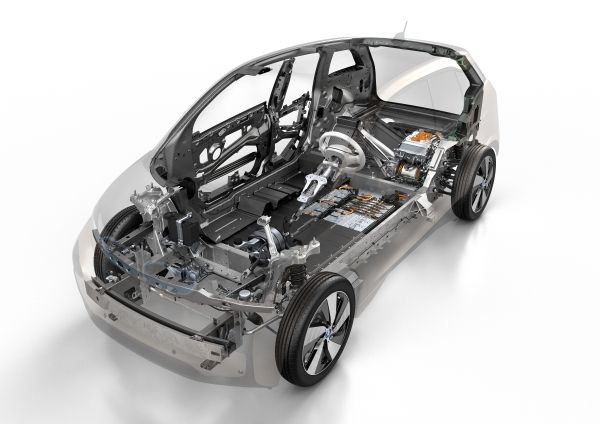 (Images courtesy of the BMW Group) Anyone who says that they're ready for the new BMW "i" electric vehicles is kidding themselves. These promise to be a total disconnect from BMW in every respect, even though BMW is insisting that the BMW driving experience will still be there. It's so new and different for BMW that we're going to let their PR meisters spin it: "The BMW i3 has been designed and conceived like no other vehicle to be powered by an electric drive system. The result is hallmark BMW driving pleasure in undiluted form, delivered with zero driving emissions and an engaging intensity unmatched by any electrically powered vehicle." If they say so. The machine’s unique architecture is based around the LifeDrive structure and its carbon-fiber-reinforced plastic (CFRP) passenger cell. The electric motor, power electronics and high-voltage lithium-ion battery have been developed and manufactured independently by the BMW Group under its BMW eDrive program. This ensures that "the BMW i sub-brand’s first car will fulfill the promise of The Ultimate Driving Machine," according to BMW.
(Images courtesy of the BMW Group) Anyone who says that they're ready for the new BMW "i" electric vehicles is kidding themselves. These promise to be a total disconnect from BMW in every respect, even though BMW is insisting that the BMW driving experience will still be there. It's so new and different for BMW that we're going to let their PR meisters spin it: "The BMW i3 has been designed and conceived like no other vehicle to be powered by an electric drive system. The result is hallmark BMW driving pleasure in undiluted form, delivered with zero driving emissions and an engaging intensity unmatched by any electrically powered vehicle." If they say so. The machine’s unique architecture is based around the LifeDrive structure and its carbon-fiber-reinforced plastic (CFRP) passenger cell. The electric motor, power electronics and high-voltage lithium-ion battery have been developed and manufactured independently by the BMW Group under its BMW eDrive program. This ensures that "the BMW i sub-brand’s first car will fulfill the promise of The Ultimate Driving Machine," according to BMW.
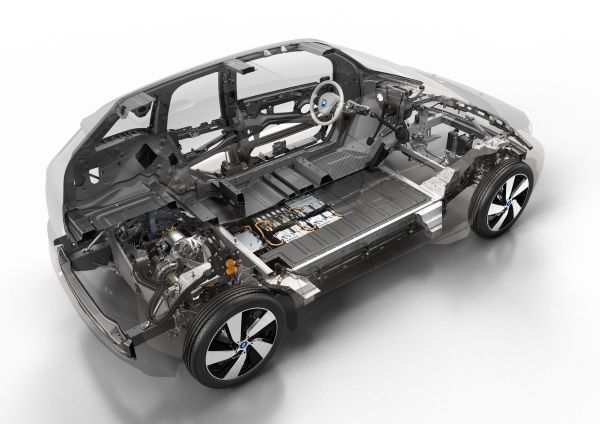
BMW says that the i3 is the result of a completely fresh concept aimed at creating the optimum balance of weight, performance and range for urban mobility. BMW says that the use of lightweight CFRP for the passenger cell cancels out the extra weight contributed by the lithium-ion battery, while the low, central positioning of the battery pack enhances the car’s agility thanks to near perfect 50:50 weight distribution. Additionally, the electric motor mounted in close proximity to the driven rear axle offers unique performance characteristics for this type of drive system as well as providing unbeatable traction. "The driving characteristics of the BMW i3 are dominated by maneuverability – a direct response to the demands of city driving. The instantaneous power delivery of the electric motor, allied to the car’s stiff suspension set-up, precise steering and impressively small turning circle (32.3 ft or 9.86 meters), produces a BMW take on electric mobility," says BMW.
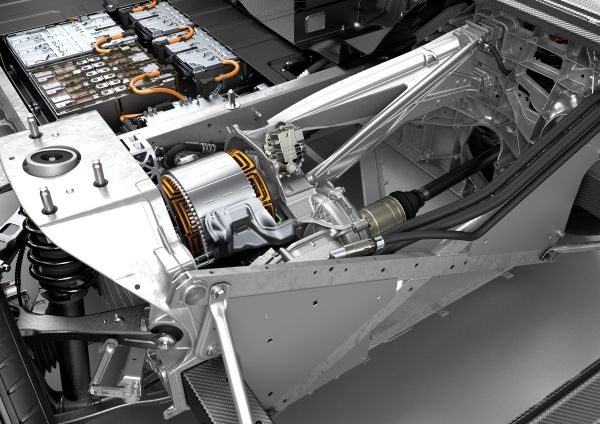 The electric motor generates output of 170hp (125 kW) and peak torque of 184 lb-ft (250 Nm), which is on tap immediately. The motor weighs just 110 lbs. (50 kg) and "boasts power density and responsiveness unprecedented in the world of electric mobility," according to BMW. The specific construction of the hybrid synchronous electric motor, developed exclusively for the BMW i3, maintains a linear flow of power into the higher reaches of the rev range. The BMW i3 sprints from 0 to 35 mph (0 - 60 km/h) in about 3.5 seconds and 0 to 60 mph (0-100 km/h) in approximately seven seconds, according to BMW. The "single-pedal control" concept in the BMW i3 – configured by the BMW Group’s drive system development engineers – also contributes to the engaging driving experience. Recuperation mode is activated the moment the driver lifts off the accelerator. The electric motor switches from drive to generator mode, feeding power into the lithium-ion battery. At the same time, it generates a precisely controllable braking effect. This recuperation is speed-sensitive, which means the car “coasts” with maximum efficiency at high speeds and generates a strong braking effect at low speeds. Uh, we'll see won't we?
The electric motor generates output of 170hp (125 kW) and peak torque of 184 lb-ft (250 Nm), which is on tap immediately. The motor weighs just 110 lbs. (50 kg) and "boasts power density and responsiveness unprecedented in the world of electric mobility," according to BMW. The specific construction of the hybrid synchronous electric motor, developed exclusively for the BMW i3, maintains a linear flow of power into the higher reaches of the rev range. The BMW i3 sprints from 0 to 35 mph (0 - 60 km/h) in about 3.5 seconds and 0 to 60 mph (0-100 km/h) in approximately seven seconds, according to BMW. The "single-pedal control" concept in the BMW i3 – configured by the BMW Group’s drive system development engineers – also contributes to the engaging driving experience. Recuperation mode is activated the moment the driver lifts off the accelerator. The electric motor switches from drive to generator mode, feeding power into the lithium-ion battery. At the same time, it generates a precisely controllable braking effect. This recuperation is speed-sensitive, which means the car “coasts” with maximum efficiency at high speeds and generates a strong braking effect at low speeds. Uh, we'll see won't we?
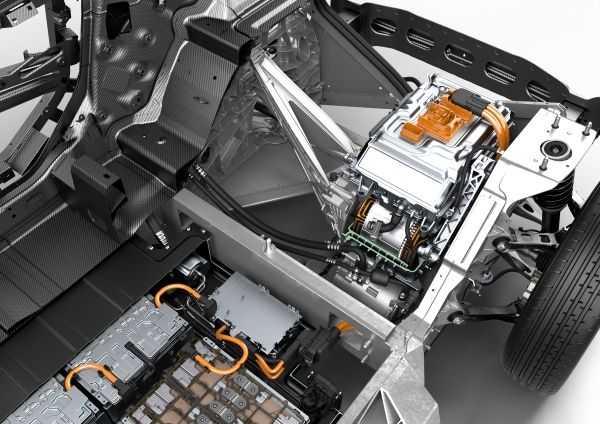 The lithium-ion battery enables the BMW i3 to achieve a range of 80 – 100 miles (130 - 160 km) in everyday driving, according to BMW. This can be increased by up to approximately 12 percent in ECO PRO mode and by the same amount again in ECO PRO+ mode. If desired, the BMW i3 is also available with a range-extender engine, which maintains the charge of the lithium-ion battery at a constant level while on the move as soon as it dips below a specified value. This role is performed by a 650cc two-cylinder gasoline engine developing 34 hp (25 kW). It is mounted adjacent to the electric motor above the rear axle. The range extender increases the car’s maximum range in day-to-day driving to around 160 – 180 miles (250 - 300 km).
The lithium-ion battery enables the BMW i3 to achieve a range of 80 – 100 miles (130 - 160 km) in everyday driving, according to BMW. This can be increased by up to approximately 12 percent in ECO PRO mode and by the same amount again in ECO PRO+ mode. If desired, the BMW i3 is also available with a range-extender engine, which maintains the charge of the lithium-ion battery at a constant level while on the move as soon as it dips below a specified value. This role is performed by a 650cc two-cylinder gasoline engine developing 34 hp (25 kW). It is mounted adjacent to the electric motor above the rear axle. The range extender increases the car’s maximum range in day-to-day driving to around 160 – 180 miles (250 - 300 km).






